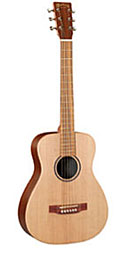
Buying your first guitar is often confusing, as you’re a beginner, and don’t know what difference tonewoods make or what makes a guitar more playable, much less what to check out before buying. To make matters worse, a lot of this information is even cryptic to musicians, and it’s easy to hear contradictory Wikipedia-esque information about what matters most in a guitar.
I’m going to write a proper guide to buying your first guitar—what to know going in, what to look for, and what to watch out for—but for the moment, I thought I’d give a quick shout out to a guitar I know well, and that I think is great for beginners and advanced players alike: The Martin LXM “Little Martin” travel guitar.
In my experience, travel guitars and smaller guitars in general are often difficult to play or sound painfully crude. While the LXM won’t sound the same as a D-28, it’s got a lot to offer.
Size: The LXM is small enough for young students to play comfortably, but large enough that adults won’t have trouble either. It’s light, comes with a soft backpack-style case, and easily fits in overhead compartments on planes. As an added bonus, using the same string sizes on the smaller guitar means the strings are looser for the same tuning, so you can have fun bending, vibrato-ing, and doing other moves that are often too difficult on acoustic guitars.
Material: The LXM is mostly made of synthetic materials, making it more durable than traditional all-wood guitars. This means you don’t have to worry as much about temperature and humidity damaging the instrument, and you don’t have to worry about bringing it camping or to the beach. Its durability and portability make it a perfect outdoor guitar. A slightly more expensive version, the LX-1 is made from real wood rather than composites.
Playability: As I mentioned above, the small size of the LXM makes the strings easier to fret, bend, and manipulate. Since I play a lot of electric guitar as well, I have fun trying to make acoustic versions of rock songs (at the moment I’m having fun making an acoustic swing-version of the Scorpions’ song “Big City Nights”). The fretboard and neck are also more ergonomic and well-made than many beginner guitars.
Sound: While the LXM isn’t going to win awards for the best tone, it’s one of the better ones for beginner guitars. When first starting out, it’s discouraging to play an instrument that sounds awful even when you’re playing correctly. This guitar has a decent tone and sustain, although it doesn’t have the volume and resonance you’d prefer when performing, even if miked.
Staying Power: Because of everything stated above, you won’t outgrow this guitar like you will a cheap, shoddy beginner guitar. Chances are you’ll enjoy having a guitar you can take on picnics, camping, beaches, parties, plane/bus/train-rides, whatever, and not worry about ruining a $1,400 instrument because it’s a bit cold this winter.
Cost: A quick internet search tells me that a new LXM is $279. This may seem a bit steep for a first guitar (after all, what if you start playing and then lose interest in guitar altogether?), but I’d say give it a go. Why Because even if you give up playing, the LXM has a good re-sell value if you don’t smash it up (which, as I mentioned, is difficult to do anyway). Check the used prices online to see what I mean.
Moreover, if you DO stick with the guitar, this will be one you’ll always love having around for outings, travels, and just casually messing around on. Even if you become the next Doc Watson, you probably won’t outgrow this guitar. As you can tell, I’m still a big fan of mine.
The LXM is part of a series with several options, such as full wood construction, rather than synthetic, and a model that includes acoustic-electric pickups. Since I bought this as a travel guitar, I am find with the cheaper, simpler synthetic-material, non-electric model (I also have a Martin D-28E for higher-quality sound and playing, but it cost as much as several LXMs).
Martin’s site focuses mostly on stats, but you’ll find info on the whole series, as well as the signature models (my favorite is the Jimmy Buffett). A simple Google search will also give you plenty of info on the LXM. Here’s a link to MyFavoriteGuitars.com, where I got mine. I had a great experience, and fully recommend them: www.MyFavoriteGuitars.com
